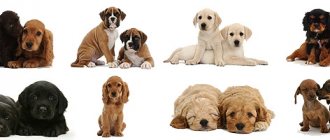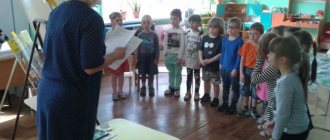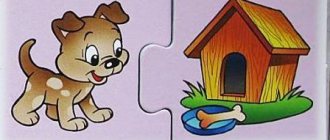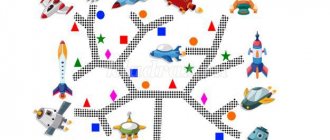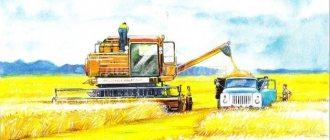Ways to play with blocks for kids
Every adult will probably come up with an obvious game with blocks - building a tower . But the possibilities of this toy are much wider!
Cubes are one of the simplest and most familiar toys. But this does not mean that they cannot be used to develop the baby’s thinking or creative abilities.
By teaching him to play with cubes, we train his powers of observation, memory, attention , and also develop ingenuity and imagination . And, using cubes, you can conduct a real physical education .
Sorting by color
Simply sorting cubes by color is a great activity for little ones.
If the set of blocks has different shades, rather than just one tone of each primary color, this will give you a great opportunity to talk about lighter and darker ones and, for little ones, start grouping colors that are similar but not exactly the same.
Here are manuals and cards for learning colors and shades with kids. You can even help your little one build a rainbow!
Character Creation
Creating characters as a game with blocks is especially fun if you have face and face blocks. Even if not, fantasize! The more room for imagination the game leaves.
Story game
Wooden cubes are not only the basis for creativity and design, but also a reason to start a story game. This type of activity is especially relevant in the company of peers.
House for mouse and giraffe
By playing with blocks, you can easily introduce your child to the concepts of higher - lower, longer - shorter or consolidate knowledge about them.
Build a tower using three cubes. Ask your child to make houses higher and lower than yours. To make the game more intense, visual and not reminiscent of a school lesson, take small toys and build houses for them. A little mouse needs a low house, but a giraffe...
Hit the target
Using blocks, you can teach a real physical education lesson. The game “Hit the Target” will develop your child’s accuracy, coordination of movements, and eye.
Place a box next to the baby (with a soft cloth on the bottom) and offer to throw cubes into it. If the baby easily copes with the task and there is not a single mistake, the box moves further and the baby moves to the next level. A distance of about one meter is ideal for this age.
Build a garage
Cups are an ideal material for building not only towers and houses, but also roads, garages, dams, parking stations, etc.
Hide and seek
Hide the cube and invite your child to look for it using the words “warmer” and “colder.”
Walk carefully!
This game is very well suited for calming a child, say, before bed. While participating in it, you don’t really get to run. So, give your baby one cube in his hand, and place the other on top of the first. It is prohibited to hold the second cube with your hand. Let the little one walk around the room with this tower. Easily?
Then we complicate the task - we put another cube on top. Now what? A performance like in a circus! Try giving your baby the blocks in the other hand.
Now offer to walk, holding only one cube in your hand. Ask your baby about his feelings.
You can diversify the task by changing the trajectory of movement or offering to carry three cubes located horizontally, holding only the outer ones. Although, of course, these options are more difficult to implement.
Three dice
The conditions of the game are as follows: the child has three cubes in his hands and walks around the room. You clap your hands rhythmically. The baby must bend down and place the blocks on the floor in time with the clapping.
For example, three claps in a row - three cubes in turn, and if clap - pause - 2 claps, then first 1 cube, then two. After arranging the cubes, the baby picks up the cubes and continues moving.
Guess the cube
Playing with eyes closed: can the child by touch identify the figure he is holding in his hands: a cube, a pyramid, a cylinder or a “gate”?
Drawing
Draw shapes around to create perfect circles, squares, triangles and rectangles!
Snake
Place the cubes around the room in one line at a distance slightly less than the child’s step. The baby will need to snake around each of them. Show your child how to do this, and then offer to try not walking, but crawling or jumping along the intended path.
Ornament
Will the child be able to put the construction set together in a certain order to make it look beautiful?
Model building
Interesting task cards can be downloaded for free on the Myshematics website.
Cross the swamp
This exercise is best done while holding your mother's hand. Place the blocks around the room at a distance slightly less than the child's step. Invite your child to travel through the swamp without getting into it. The baby should walk, stepping only on the cubes. Don't feel like you have to do this task with shoes on. Foot massage is the best prevention of flat feet.
Lesson on speech development in the senior group on the topic “My home is my fortress”
1. What kind of wooden house? - wood. 2. And if the house is made of stone, it’s stone
3. Made from straw - straw 4. Made from ice - ice
5. Made of brick - brick 6. Made of cardboard - cardboard
7. Made of concrete - concrete.
You speak very beautifully and correctly, but let’s try to play “Echo” with you (Game “Echo” - the teacher pronounces the syllables, and the children repeat quietly)
Do-to-do Yes-ta-da Shower-toosh-shower House-tom-house Smoke-tom-smoke
Well done, and I propose to make the walls of our house from fairy tales about friendship! After all, fairy-tale heroes also know how to be friends, right?
Let's remember these tales of friendship
. (Children's answers: The seven-flowered flower. Teremok. Bremen Town Musicians. Winnie the Pooh. The Three Little Pigs. The Snow Queen.
Educator: Let's remember once again who were friends in these fairy tales?
(Children’s answers when viewing illustrations for fairy tales.)
Educator: Yes, children, these are all tales about friendship.
(After the fairy tales, the walls of the house
)
Educator: We are great, the walls are already standing. Now we need to build... what?
Children: Roof
Educator: Tell me, how many syllables are in the word roof? (dividing words into syllables)
house, wall, fairy tale, foundation, children, friendship, house, work, window, door, chair, winter, snowman, frost, well done.
Let's remember what our speech consists of? sentences? words? syllables?
What do we know about sounds?
We cannot see the sound and we cannot take it in our hands,
We can only hear the sound and also say it.
We hear and pronounce sounds
And we see and write letters.
Tell me, guys, what are the sounds? How do vowel sounds differ from consonants? What are the consonant sounds? What color are they indicated by?
How many syllables are in the word HOUSE Children: 1
Educator: Children, tell me, how many sounds are there? (3)
Let's lay out a sound model of the word HOME
And now Danya will show us all how to do it right...
Educator: So we sorted out the word HOME together, together.
Tell me how to call the HOUSE affectionately (children answer) HOUSE!
Right! Now I will check whether you have completed the sound analysis of the word; if you complete the task correctly, then a roof will appear on our house.
(Roof)
Oh, look, you and I work so well that our house now has a roof.
Physical school
One two three four five. (Children jump on the spot) Let's build and play. We are building a big, tall house. (They stand on their toes and stretch their arms up) We install windows and build a roof. (Show the window, the roof with your hands - clasp your hands above your head) What a beautiful house! (They extend their arms forward with an index gesture) An old gnome will live in it. (Squat)
Take, children, a white lump (make a small circle in the air with your hands, bending forward); We will pour water on it, (sit down, “lifting the bucket and pouring out the water”) The house will be icy (tilts of the body to the right - left, hands on the belt) We put lump after lump, (tilts left and right, taking lump after lump and folding them one by one for one;) So they sculpted the house. (stretch on your toes, arms up (big house))
The benefits of playing with wooden blocks for kids
Why should children play with this seemingly simple toy? For babies over one year old:
- Hone fine motor skills - build towers;
- Coordinate hands and eyes - connect blocks to create sounds and place one on top of the other;
- Understand the connection between cause and effect - find out that a fallen brick makes noise;
- Learn new words - animal names and sounds, colors, shapes, etc.;
- Gain sensory experiences - bringing blocks to the mouth, touching them, perceiving the sounds they create when they come into contact with other things, the texture of the paint on the blocks, bright colors stimulate the child's senses;
- Study prepositions - put blocks in and out of the bag, put them next to, behind, in front of, etc.
- Understand the permanence of the object - that the blocks are still there even if they can't see them.
For preschool children over 3 years old:
- Imaginative play - using blocks to tell a story
- Model building - using cubes to create more complex models than a simple tower,
- Memory game and repetition in a complex pattern,
- Studying a subject, such as talking about what food each animal eats,
- Simple addition and subtraction, grouping similar objects.
